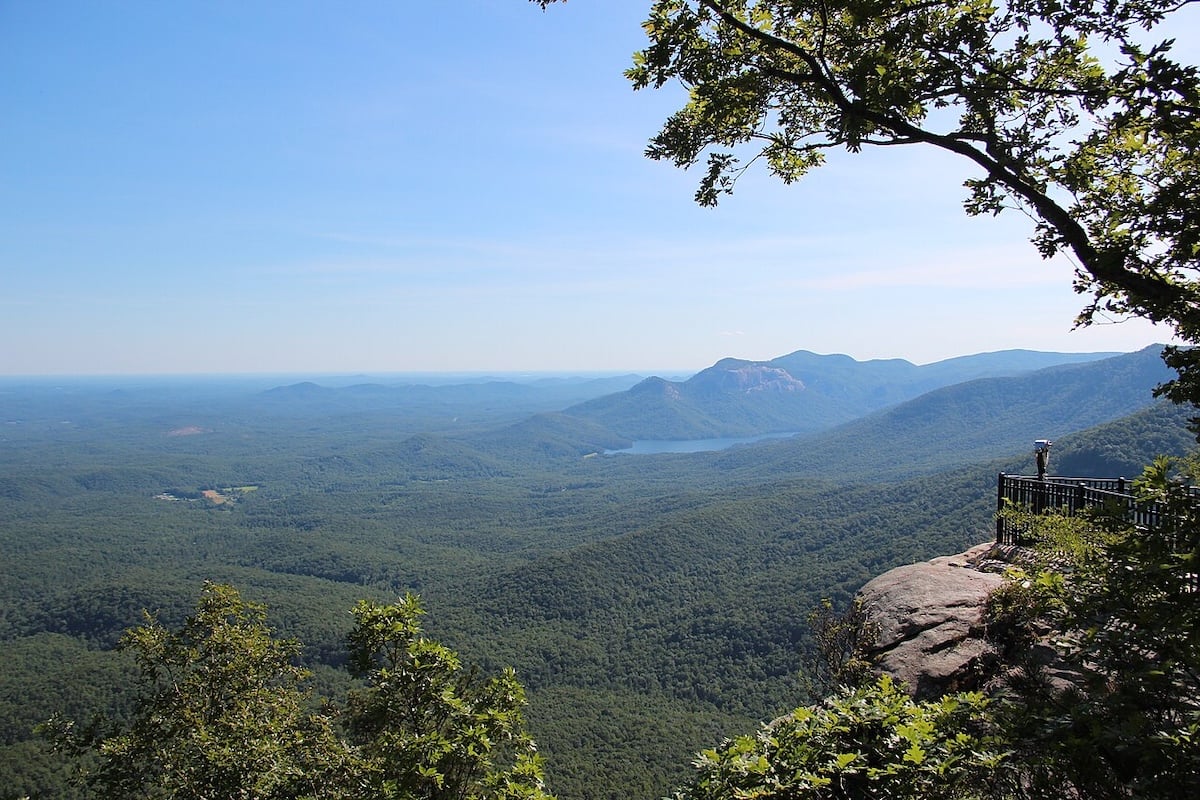
Best counties to live in South Carolina based on a variety of variables including median home prices
More counties in the United States experienced population growth in the last year, according to the latest Census data, even as pandemic-related moving trends begin to normalize.
Counties in the South continued to experience growth, particularly in Florida, where 96% of its 67 counties gained new residents. Polk County, Florida, a suburb of Orlando, added the most, with 26,000 people moving there in 2023.
Meanwhile, counties in the Midwest and Northeast continued to lose population, but at slower rates than the year before. Some of the biggest losses were in counties home to large cities, including Cook County, Illinois (home of Chicago) and the boroughs of Brooklyn and Queens in New York.
Many counties are experiencing growth due to their job opportunities, education, or relatively affordable housing costs. Others are favored for their historic or well-designed downtowns or access to cultural opportunities.
Stacker compiled a list of the best counties to live in South Carolina using rankings from Niche. Niche ranks counties by various factors including public schools, educational attainment, cost of living, and housing.
Keep reading to see if your county made the list.
You may also like: South Carolina ranks #36 in mental health care deserts

#30. Chesterfield County, South Carolina
– Overall Rank: 1,313
– Population: 43,536
– Median household income: $46,326
– Median home value: $91,400 (72% own)
– Median rent: $796 (28% rent)
– Top public schools: Plainview Elementary School (grade B), Edwards Elementary School (grade B), Chesterfield High School (grade B minus)
– Top private schools: South Pointe Christian School (grade B minus), Jesus Is Lord Christian School (grade unavailable), Faith Christian Academy (grade unavailable)
– Top places: Pageland (grade B minus), Cheraw (grade C+), Chesterfield (grade B)

About
Chesterfield County, South Carolina is part of the Pee Dee region, where farming traditions and rural life continue to shape its identity. Its fields, pine forests, and waterways create a landscape that has long supported agriculture and close community ties. Towns such as Chesterfield, Cheraw, and Pageland balance historic preservation with steady, small-scale growth.
Festivals, school events, and local markets bring residents together in celebration of culture and tradition. Outdoor recreation in rivers, parks, and preserves strengthens the county’s bond with its natural surroundings. Chesterfield County embodies resilience, heritage, and the enduring spirit of rural South Carolina living.
Where is Chesterfield County?
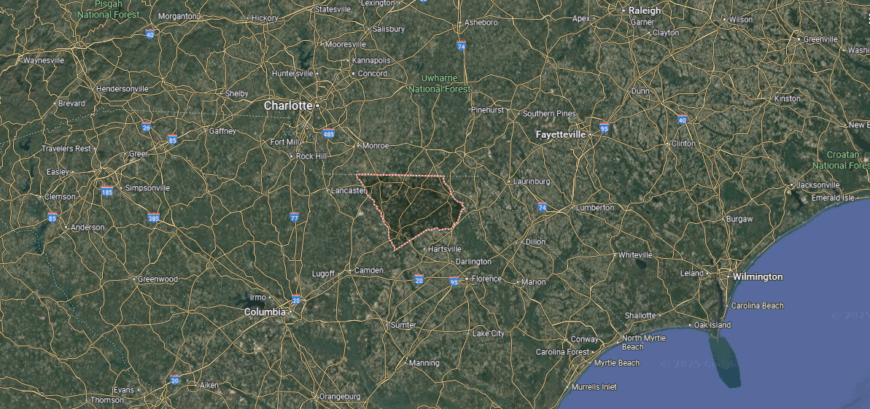
Chesterfield County is located in the north-central part of South Carolina, bordering North Carolina to the north. It is surrounded by Lancaster County to the west, Marlboro and Darlington counties to the east and south, and Anson and Union counties in North Carolina. The county stretches about 50 miles north to south and 35 miles east to west.
The county seat, Chesterfield, sits near the center, while Cheraw, the largest town, lies along the Great Pee Dee River in the northeast. Other towns include Pageland in the southwest, Jefferson in the northwest, and McBee in the southeast. Chesterfield County features rolling farmlands, pine forests, and natural areas such as the Sand Hills State Forest and the Pee Dee River.
#29. Bamberg County, South Carolina
– Overall Rank: 1,312
– Population: 13,311
– Median household income: $43,920
– Median home value: $97,200 (74% own)
– Median rent: $772 (26% rent)
– Top public schools: Bamberg-Ehrhardt High School (grade B), Bamberg-Ehrhardt Middle School (grade B minus), Richard Carroll Elementary School (grade B minus)
– Top private schools: Andrew Jackson Academy (grade B)
– Top places: Bamberg (grade B minus), Denmark (grade C), Ehrhardt (grade B)

About
Bamberg County, South Carolina reflects a quiet stretch of the Lowcountry where agriculture has long been the backbone of daily life. Cotton fields, timberlands, and farmlands shape the local economy while tying generations to the land. Small towns across the county maintain a steady pace, rooted in tradition and family-centered living.
Community life finds expression in church gatherings, school events, and seasonal celebrations that keep neighbors closely connected. Fishing, hunting, and outdoor recreation along rivers and woodlands add to the county’s sense of place. Bamberg County stands as a testament to endurance, heritage, and the rhythms of rural South Carolina.
Where is Bamberg County?
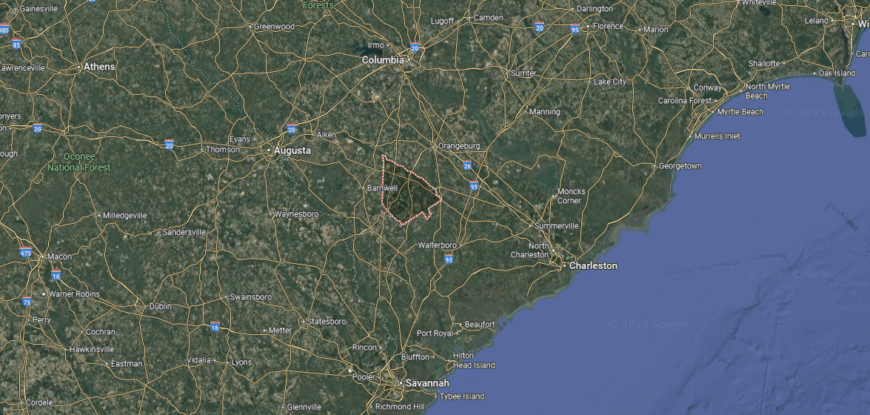
Bamberg County lies in the southwestern part of South Carolina, positioned between Orangeburg County to the north and Barnwell County to the west. To its south and east, it borders Colleton and Hampton counties, placing it within the state’s Lowcountry region. The county stretches approximately 35 miles from east to west and 25 miles north to south.
Bamberg serves as the county seat, located near the center, while Denmark, the largest town, sits just to the northwest along U.S. Highway 78. Smaller communities such as Ehrhardt and Govan add to the county’s rural character. The landscape is defined by flat agricultural fields, pine woodlands, and waterways connected to the Edisto River system.
#28. Darlington County, South Carolina
– Overall Rank: 1,028
– Population: 63,025
– Median household income: $44,317
– Median home value: $132,600 (69% own)
– Median rent: $804 (31% rent)
– Top public schools: South Carolina Governor’s School for Science & Mathematics (grade A+), Mayo High School for Math, Science & Technology (grade A+), Carolina Elementary School (grade A minus)
– Top private schools: Trinity Collegiate School (grade A), Emmanuel Christian School (grade B), Thomas Hart Academy (grade unavailable)
– Top places: North Hartsville (grade A), Hartsville (grade B+), Darlington (grade C)

About
Darlington County, South Carolina is known for its strong ties to both history and tradition, blending agricultural roots with a legacy in industry and culture. The county seat of Darlington carries a reputation beyond its size thanks to its historic downtown and connections to community life. Surrounding towns and farmlands reflect a balance of progress and rural identity.
Life here is marked by shared traditions, from local festivals to gatherings centered on schools and churches. Outdoor spaces, including rivers, fields, and parks, provide residents with both livelihood and recreation. Darlington County remains a place where heritage, community pride, and a steady pace of living come together.
Where is Darlington County?
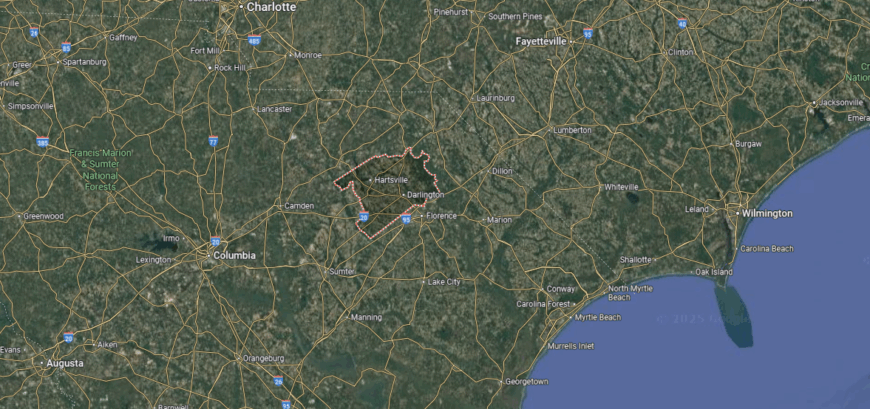
Darlington County is situated in the northeastern section of South Carolina, forming part of the Pee Dee region. It is bordered by Marlboro and Florence counties to the east, Chesterfield to the north, and Lee and Kershaw to the west. The county extends about 40 miles across, with a mix of farmland, forested tracts, and river valleys shaping its geography.
Darlington, the county seat, rests near the center, while Hartsville, the largest city, lies to the northwest. Other notable communities include Lamar to the south and Society Hill to the north along the Pee Dee River. Known for its ties to agriculture and industry, the county is also home to the Darlington Raceway, a landmark that places it on the national map.
#27. Saluda County, South Carolina
– Overall Rank: 978
– Population: 18,952
– Median household income: $51,041
– Median home value: $117,800 (78% own)
– Median rent: $709 (22% rent)
– Top public schools: Hollywood Elementary School (grade B+), Saluda Middle School (grade B minus), Saluda Elementary School (grade B minus)
– Top private schools: W. Wyman King Academy (grade B+)
– Top places: Saluda (grade B), Ridge Spring (grade B), Ward (grade B minus)

About
Saluda County, South Carolina carries a heritage rooted in farming, with rolling fields and rural landscapes shaping its way of life. The town of Saluda, serving as the county seat, reflects a blend of historic charm and civic tradition that anchors the community. Across the county, small towns and open countryside maintain a close connection to both land and history.
Residents gather for agricultural fairs, school events, and church-centered activities that strengthen social ties. Outdoor spaces such as lakes, rivers, and farmlands provide both recreation and a sense of continuity with the past. Saluda County endures as a place where tradition, resilience, and rural values define everyday living.
Where is Saluda County?
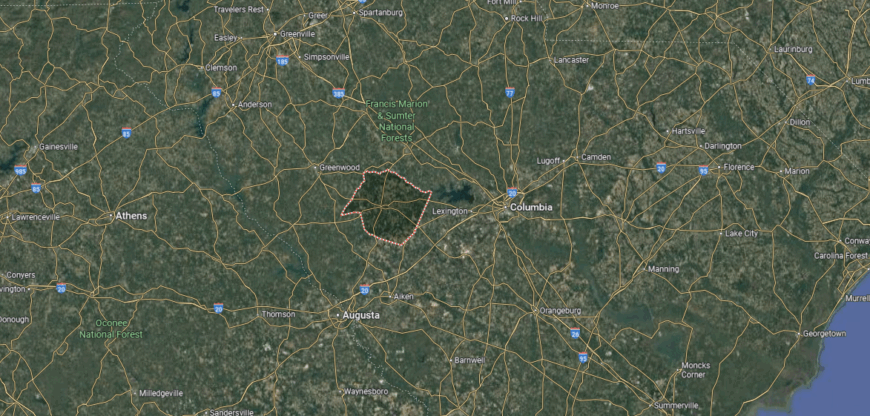
Saluda County sits in the central western portion of South Carolina, bordered by Newberry County to the north and Lexington County to the east. To the south, it meets Aiken and Edgefield counties, while Greenwood and McCormick counties lie to the west. Covering about 45 miles from north to south, the county blends rolling farmland with forested stretches and river boundaries.
The town of Saluda serves as the county seat, positioned near the center of the county. Other towns include Ridge Spring in the southeast and Ward to the west, each contributing to the county’s rural landscape. The Saluda River flows along the eastern edge, linking the area to Lake Murray and adding recreational and natural significance to the region.
#26. Sumter County, South Carolina
– Overall Rank: 976
– Population: 105,199
– Median household income: $53,970
– Median home value: $146,300 (66% own)
– Median rent: $995 (34% rent)
– Top public schools: Alice Drive Elementary School (grade B), Millwood Elementary School (grade B minus), Hillcrest Middle School (grade C+)
– Top private schools: Wilson Hall (grade A), Thomas Sumter Academy (grade B+), Westside Christian Academy (grade unavailable)
– Top places: Oakland (grade B+), Stateburg (grade B), Cane Savannah (grade B)
You may also like: Best colleges in South Carolina

About
Sumter County, South Carolina reflects a meeting point of history, agriculture, and modern community life in the heart of the state. The city of Sumter, the county seat, serves as a hub where historic landmarks and civic institutions anchor the region. Surrounding farmlands and small towns maintain a steady connection to the land and local traditions.
Community spirit thrives through cultural festivals, school activities, and gatherings that highlight both heritage and progress. Parks, lakes, and natural preserves offer residents space for recreation and reflection. Sumter County stands as a blend of tradition and growth, carrying forward a sense of identity shaped by its people and landscape.
Where is Sumter County?

Sumter County is positioned in the east-central portion of South Carolina, within the state’s Inner Coastal Plain. It is bordered by Lee County to the north, Clarendon County to the south, and Florence County to the east, with Richland and Calhoun counties lying to the west. The county spans roughly 40 miles in each direction, consisting of fertile farmland, wetlands, and river basins tied to the Wateree and Santee rivers.
The city of Sumter, which serves as the county seat and largest community, is located near the center. Surrounding towns include Mayesville to the east, Pinewood to the southwest, and Dalzell to the north. Shaw Air Force Base and Swan Lake Iris Gardens stand out as key landmarks, highlighting both the county’s military presence and natural beauty.
#25. Cherokee County, South Carolina
– Overall Rank: 974
– Population: 56,200
– Median household income: $47,011
– Median home value: $124,500 (71% own)
– Median rent: $828 (29% rent)
– Top public schools: Corinth Elementary School (grade B), Grassy Pond Elementary School (grade B), Northwest Elementary School (grade B)
– Top private schools: The Village School (grade unavailable)
– Top places: Gaffney (grade B minus), East Gaffney (grade B minus), Blacksburg (grade C)

About
Cherokee County, South Carolina is defined by its foothills setting and a history that reaches back to the Revolutionary era. The county seat of Gaffney, with its iconic Peachoid water tower and historic districts, reflects both local pride and ties to tradition. Textile roots, agriculture, and a growing industrial presence give the county a diverse character shaped by past and present.
Community life is enriched through school events, cultural festivals, and gatherings that highlight both heritage and neighborly connection. Outdoor opportunities in the surrounding hills and rivers keep residents linked to the natural environment. Cherokee County remains a place where history, resilience, and community spirit come together in lasting form.
Where is Cherokee County?
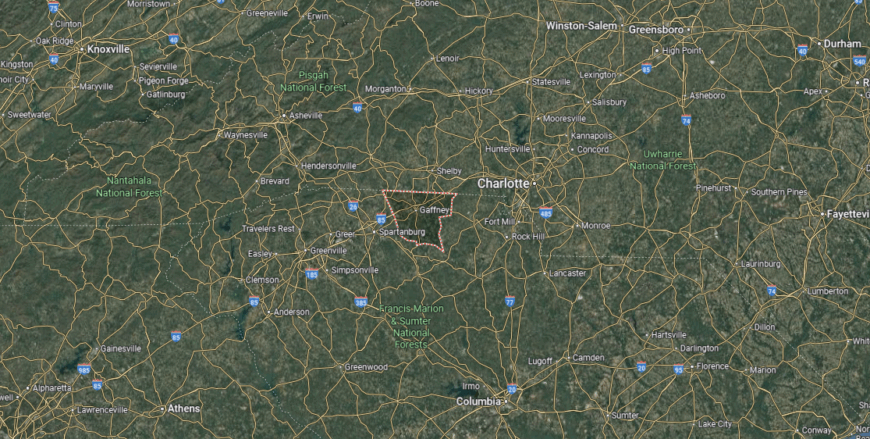
Cherokee County sits in the northwestern corner of South Carolina, within the state’s Upstate region. It shares its northern boundary with North Carolina, while Spartanburg County borders it to the south and York County to the east. The county stretches about 30 miles across, with a terrain marked by rolling hills and river valleys along the Broad and Pacolet rivers.
Gaffney, the county seat and largest city, is located near the center, just off Interstate 85. Other nearby towns include Blacksburg to the north and Chesnee on the southern edge. Cherokee County is noted for its historic ties to the Revolutionary War, as well as landmarks like the famous Peachoid water tower and the Cowpens National Battlefield.
#24. Edgefield County, South Carolina
– Overall Rank: 899
– Population: 26,181
– Median household income: $60,033
– Median home value: $162,900 (75% own)
– Median rent: $786 (25% rent)
– Top public schools: Fox Creek Charter High School (grade A minus), Merriwether Middle School (grade B), Merriwether Elementary School (grade B minus)
– Top private schools: Francis Hugh Wardlaw Academy (grade B+)
– Top places: Murphys Estates (grade B), Edgefield (grade B minus), Trenton (grade B)

About
Edgefield County, South Carolina is steeped in history, long recognized for its political legacy and craftsmanship in pottery. The town of Edgefield, serving as the county seat, preserves historic buildings and cultural landmarks that anchor its identity. Surrounding farmlands and forests carry forward traditions of agriculture and rural living that remain central to the county’s character.
Local festivals, art displays, and community gatherings keep heritage alive while creating spaces for connection among residents. Outdoor recreation in parks, trails, and scenic countryside further strengthens ties to the land. Edgefield County stands as a place where history, artistry, and community values shape a distinct and enduring way of life.
Where is Edgefield County?
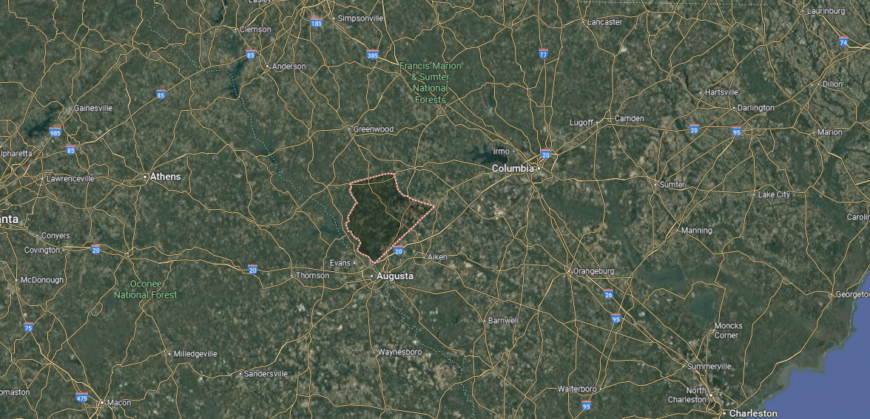
Edgefield County lies along the western border of South Carolina, sharing its boundary with Georgia across the Savannah River. It is bordered by McCormick and Greenwood counties to the north, Saluda County to the east, and Aiken County to the south. Covering about 35 miles north to south and 30 miles east to west, the county is defined by gently rolling hills and fertile river valleys.
The town of Edgefield serves as the county seat, located near the geographic center. Johnston, in the eastern part of the county, is known for its peach orchards, while Trenton lies nearby along U.S. Highway 25. With its agricultural base, historic districts, and connection to the Savannah River, Edgefield County blends rural charm with deep historical significance.
#23. Calhoun County, South Carolina
– Overall Rank: 890
– Population: 14,145
– Median household income: $55,550
– Median home value: $130,900 (83% own)
– Median rent: $968 (17% rent)
– Top public schools: Calhoun County High School (grade B), Sandy Run School (grade B minus), St. Matthews School (grade C)
– Top private schools: Calhoun Academy (grade B minus), Upward Way Christian Academy (grade unavailable)
– Top places: Cameron (grade B minus), St. Matthews (grade B minus)

About
Calhoun County, South Carolina reflects the character of a small, close-knit community shaped by its agricultural foundation. The county seat of St. Matthews centers civic life with historic landmarks and institutions that tie residents to their roots. Fields, farms, and open countryside provide both livelihood and identity, linking the present to generations of rural tradition.
Cultural events, church gatherings, and local celebrations strengthen bonds across families and neighbors. Outdoor recreation along rivers, farmland, and woodlands adds to the rhythm of daily life. Calhoun County remains defined by heritage, community resilience, and the steady pace of rural South Carolina living.
Where is Calhoun County?

Calhoun County is located in the central part of South Carolina, within the fertile lands of the Congaree River valley. It is bordered by Richland County to the north, Orangeburg County to the south, and Lexington County to the west. The county spans about 30 miles across, combining farmland, forested areas, and river floodplains.
St. Matthews, the county seat, sits near the center and serves as the largest town. Smaller communities include Sandy Run to the northwest and Fort Motte near the Congaree River. With its agricultural foundation and proximity to both Columbia and the Congaree National Park, Calhoun County holds a mix of rural landscapes and easy access to urban and natural attractions.
#22. Berkeley County, South Carolina
– Overall Rank: 860
– Population: 231,419
– Median household income: $77,874
– Median home value: $253,100 (74% own)
– Median rent: $1,410 (26% rent)
– Top public schools: Berkeley County Middle College High School (grade A), Hanahan High School (grade A minus), Marrington Middle School of the Arts (grade A minus)
– Top private schools: Bishop England High School (grade A minus), Ridge Christian Academy (grade B+), St. John’s Christian Academy (grade B)
– Top places: Hanahan (grade A minus), Goose Creek (grade B+), Ladson (grade B+)

About
Berkeley County, South Carolina stretches across the Lowcountry, where wetlands, rivers, and pine forests shape both the landscape and the life of its people. The county seat of Moncks Corner serves as a central gathering place, while nearby communities balance growth with preservation of history and natural resources. With roots in agriculture, trade, and waterways, the county reflects a blend of tradition and steady development.
Life here is enriched by festivals, outdoor recreation on Lake Moultrie and the Cooper River, and civic events that bring residents together. Historic sites and cultural landmarks stand alongside modern institutions, reflecting both heritage and progress. Berkeley County endures as a region where natural beauty, community pride, and evolving opportunity come together in lasting form.
Where is Berkeley County?
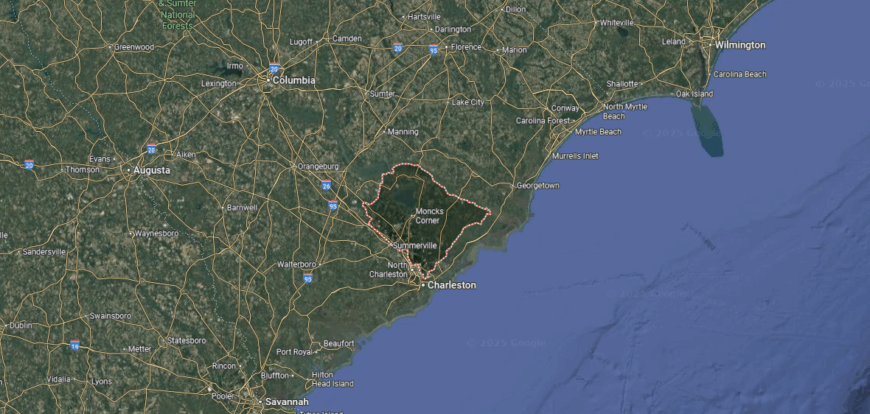
Berkeley County stretches across the southeastern part of South Carolina, forming part of the Charleston metropolitan area. It is bordered by Georgetown County to the northeast, Charleston County to the south, and Dorchester County to the west. The county’s geography blends coastal plains, extensive waterways, and forested tracts, covering nearly 1,200 square miles.
Moncks Corner, the county seat, lies near the center and is often referred to as the “Capital of Santee Cooper Country.” Other notable communities include Goose Creek, Hanahan, and parts of Summerville, which extend into its boundaries. With Lake Moultrie, the Cooper River, and Francis Marion National Forest shaping much of its identity, Berkeley County combines historic settlements with vital natural resources.
#21. Abbeville County, South Carolina
– Overall Rank: 785
– Population: 24,368
– Median household income: $49,759
– Median home value: $118,400 (76% own)
– Median rent: $791 (24% rent)
– Top public schools: Cherokee Trail Elementary School (grade B+), Wright Middle School (grade B+), Diamond Hill Elementary School (grade B)
– Top private schools: Cold Springs Mennonite School (grade unavailable), Shiloh Christian School (grade unavailable)
– Top places: Abbeville (grade B), Due West (grade A), Donalds (grade B)
You may also like: Risky reservoirs: South Carolina counties where aging dams pose the greatest threat

About
Abbeville County, South Carolina carries a legacy as one of the state’s historic upcountry regions, where small towns and rural landscapes define its character. The city of Abbeville, the county seat, is known for its historic square and cultural landmarks that anchor community life. Agriculture, forestry, and local traditions continue to shape both the economy and daily living.
Residents gather for performances, festivals, and church events that reflect pride in heritage and strengthen social ties. Outdoor opportunities in lakes, forests, and open fields provide recreation while maintaining a deep connection to the land. Abbeville County endures as a place where history, community, and rural values are woven into everyday life.
Where is Abbeville County?
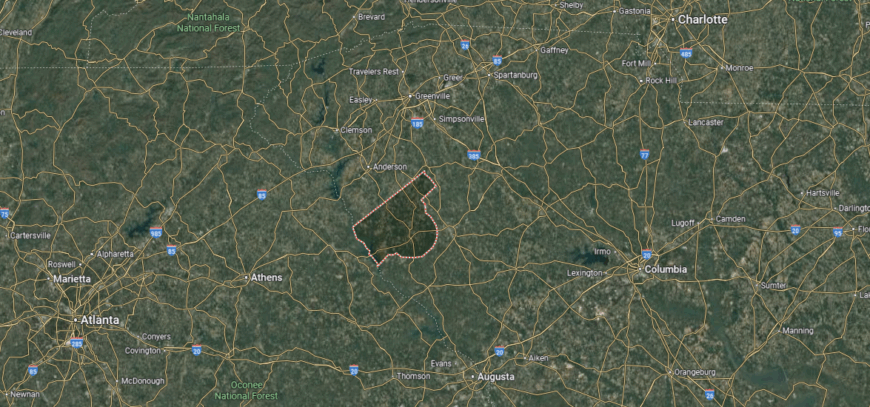
Abbeville County sits in the northwestern portion of South Carolina, within the state’s Piedmont region. It shares its western border with Georgia along the Savannah River, while Greenwood County lies to the east and McCormick and Anderson counties border it to the south and north. The county extends roughly 35 miles across, marked by rolling hills, lakes, and fertile valleys.
The city of Abbeville, serving as the county seat, is positioned near the center and is known for its historic courthouse square. Other communities include Calhoun Falls along Lake Russell and Due West, home to Erskine College. With its blend of agricultural lands, historic towns, and proximity to both the Savannah River and Lake Russell, Abbeville County holds a distinct balance of heritage and natural beauty.
#20. Newberry County, South Carolina
– Overall Rank: 782
– Population: 37,918
– Median household income: $56,706
– Median home value: $139,200 (74% own)
– Median rent: $855 (26% rent)
– Top public schools: Little Mountain Elementary School (grade B+), Mid-Carolina Middle School (grade B+), Whitmire Community Elementary School (grade B)
– Top private schools: Newberry Academy (grade A minus), Newberry Christian Academy (grade unavailable)
– Top places: Newberry (grade B+), Little Mountain (grade A minus), Silverstreet (grade B+)

About
Newberry County, South Carolina reflects a blend of historic charm and rural tradition set within the state’s Midlands. The city of Newberry, with its preserved downtown and cultural institutions, serves as the county’s heart and anchor. Surrounding farmland, forests, and small towns maintain a steady connection to agriculture and community-centered living.
Festivals, concerts, and school events provide opportunities for neighbors to gather and celebrate shared traditions. Outdoor recreation at Lake Murray and nearby parks keeps residents linked to the natural landscape. Newberry County endures as a place where history, culture, and rural heritage shape a balanced way of life.
Where is Newberry County?
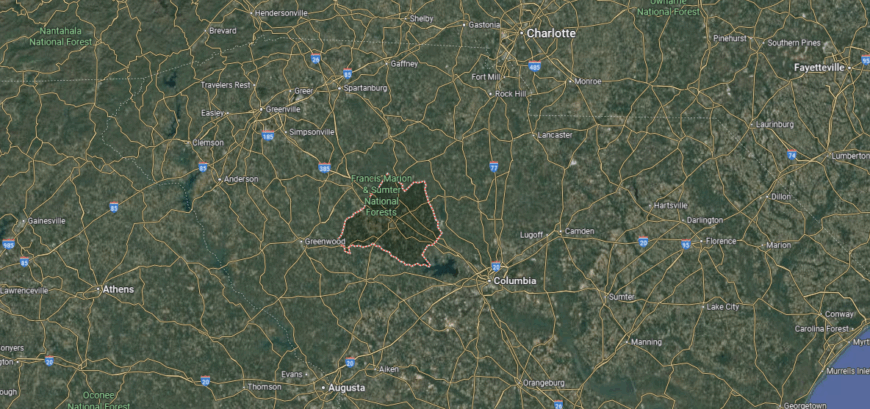
Newberry County is located in the central Piedmont region of South Carolina, set between the Broad and Saluda rivers. It is bordered by Laurens County to the northwest, Fairfield County to the northeast, and Lexington and Richland counties to the southeast. The land stretches about 40 miles across, featuring rolling hills, farmland, and wooded areas characteristic of the Midlands.
The city of Newberry, the county seat, lies near the center and serves as the hub for culture and government. Smaller towns such as Prosperity to the southeast and Whitmire in the north provide additional community centers. Lake Murray, which touches the southern edge, and the Sumter National Forest in the north highlight the county’s mix of recreational opportunities and natural settings.
#19. Laurens County, South Carolina
– Overall Rank: 774
– Population: 67,456
– Median household income: $52,077
– Median home value: $138,600 (71% own)
– Median rent: $826 (29% rent)
– Top public schools: Clinton Elementary School (grade B), Clinton Middle School (grade B), Clinton High School (grade B minus)
– Top private schools: Laurens Academy (grade B), Fountain Inn Christian School (grade unavailable), Lighthouse Christian Academy (grade unavailable)
– Top places: Joanna (grade B+), Clinton (grade B), Laurens (grade B minus)

About
Laurens County, South Carolina is marked by its position in the Piedmont, where rolling hills and small towns reflect a balance of heritage and progress. The county seat of Laurens preserves historic architecture and civic institutions that root the community in tradition. Across the county, agriculture, industry, and commerce weave together to sustain its people and economy.
Community bonds are strengthened through festivals, school activities, and church-centered gatherings that highlight local pride. Outdoor recreation in parks, lakes, and trails keeps residents connected to the land. Laurens County stands as a place where history, resilience, and rural values continue to guide everyday life.
Where is Laurens County?

Laurens County sits in the northwestern section of South Carolina, part of the state’s Upstate region. It is bordered by Greenville County to the north, Newberry County to the southeast, and Greenwood County to the southwest. The terrain extends about 40 miles across, with rolling hills, forestlands, and stretches of farmland defining much of its landscape.
Laurens, the county seat, is located near the center, while Clinton in the southeast stands as another major community. Other towns include Gray Court to the north and Cross Hill near Lake Greenwood. With the Enoree River on its northern edge and Lake Greenwood along the southern border, Laurens County combines natural waterways with small-town centers and a strong rural character.
#18. Greenwood County, South Carolina
– Overall Rank: 640
– Population: 69,309
– Median household income: $47,553
– Median home value: $144,000 (65% own)
– Median rent: $849 (35% rent)
– Top public schools: Ninety Six Elementary School (grade A minus), Edgewood Middle School (grade B+), Hodges Elementary School (grade B)
– Top private schools: Palmetto Christian Academy of Greenwood (grade A minus), Cambridge Academy (grade B+), Greenwood Christian School (grade B)
– Top places: Greenwood (grade B minus), Ninety Six (grade B+), Promised Land (grade B minus)
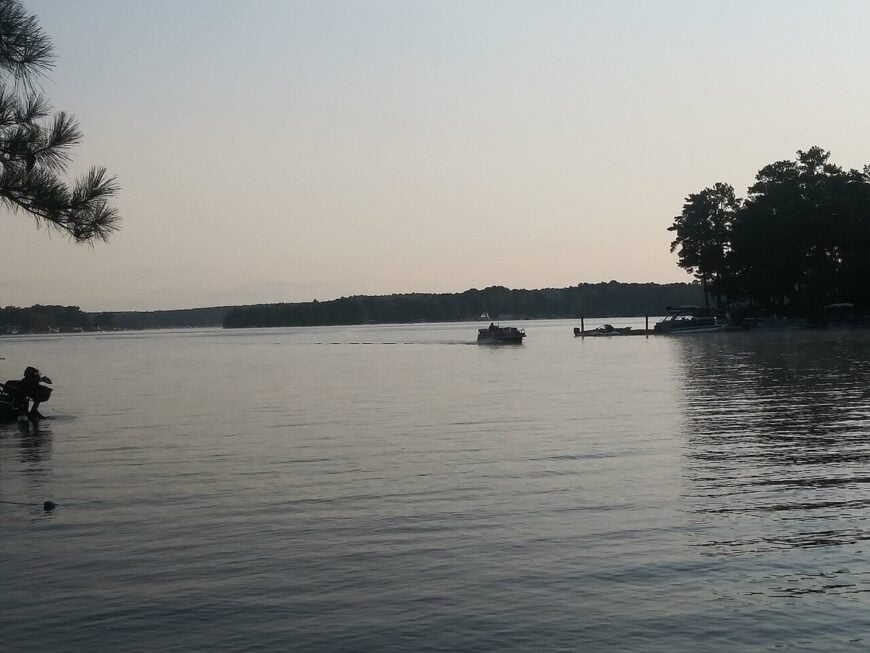
About
Greenwood County, South Carolina is shaped by both its historic roots and its role as a cultural hub in the Piedmont. The city of Greenwood anchors the county with its preserved downtown, civic institutions, and ties to industry and trade. Surrounding farmland, forests, and lakes provide a rural backdrop that balances tradition with modern growth.
Residents gather for festivals, concerts, and community events that showcase local culture and strengthen social ties. Outdoor life thrives around Lake Greenwood and nearby parks, offering space for recreation and reflection. Greenwood County remains a place where heritage, community spirit, and natural beauty come together in enduring form.
Where is Greenwood County?
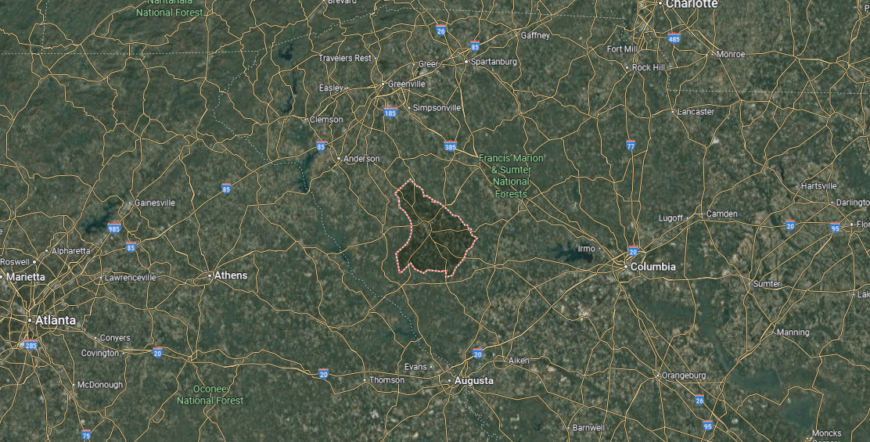
Greenwood County lies in the western Midlands of South Carolina, surrounded by Laurens County to the north, Abbeville County to the west, and Saluda County to the east. To the south, it meets Edgefield and McCormick counties, placing it in a region that bridges the Piedmont with the state’s lake country. The county spans roughly 45 miles across, with gently rolling terrain and fertile lands shaped by rivers and reservoirs.
The city of Greenwood, serving as the county seat and largest community, sits near the center and anchors much of the region’s activity. Other towns include Ninety Six to the southeast, known for its Revolutionary War history, and Ware Shoals to the north along the Saluda River. With Lake Greenwood stretching across its eastern boundary, the county blends agricultural areas, historic landmarks, and recreational waterways.
#17. Georgetown County, South Carolina
– Overall Rank: 623
– Population: 63,594
– Median household income: $59,782
– Median home value: $234,600 (82% own)
– Median rent: $1,046 (18% rent)
– Top public schools: Waccamaw Elementary School (grade B+), Waccamaw Middle School (grade B+), Waccamaw High School (grade B+)
– Top private schools: The Georgetown School of Arts & Sciences (grade A+), Lowcountry Preparatory School (grade A), Little Smurfs CDC (grade unavailable)
– Top places: Murrells Inlet (grade A minus), Georgetown (grade B minus), Andrews (grade C+)

About
Georgetown County, South Carolina stretches along the coast, where rivers, marshlands, and the Atlantic Ocean shape both its history and daily life. The city of Georgetown, one of the state’s oldest communities, reflects a legacy of trade, rice culture, and historic preservation. Small towns and coastal villages throughout the county balance fishing, farming, and tourism with a deep respect for the land and water.
Community gatherings, seafood festivals, and cultural events highlight the area’s traditions and bring residents together. Outdoor opportunities thrive along beaches, waterways, and natural preserves that define the region’s character. Georgetown County stands as a coastal landscape where history, heritage, and natural beauty remain closely intertwined.
Where is Georgetown County?
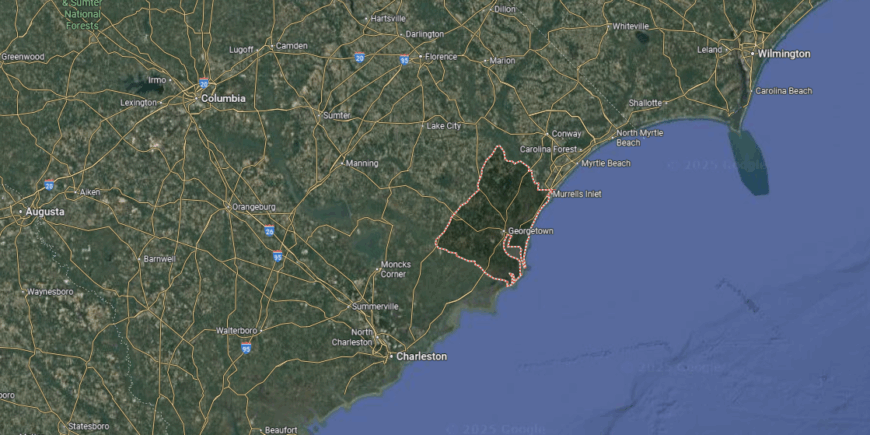
Georgetown County is positioned along the South Carolina coast, midway between Charleston and Myrtle Beach. It is bordered by Horry County to the north, Williamsburg County to the west, and Charleston County to the south, with the Atlantic Ocean forming its eastern edge. The county spans barrier islands, tidal marshes, rivers, and pine uplands, creating one of the most diverse landscapes in the state.
The city of Georgetown, serving as the county seat, sits at the confluence of the Great Pee Dee, Waccamaw, Sampit, and Black rivers. Other communities include Andrews to the west, Pawleys Island to the northeast, and Murrells Inlet on the northern coast. Known for its historic port, rice-growing heritage, and natural beauty, Georgetown County today blends coastal living with waterways and protected lands such as the Waccamaw National Wildlife Refuge.
#16. Lancaster County, South Carolina
– Overall Rank: 556
– Population: 97,611
– Median household income: $72,186
– Median home value: $272,100 (82% own)
– Median rent: $881 (18% rent)
– Top public schools: Harrisburg Elementary School (grade A minus), Van Wyck Elementary School (grade A minus), Indian Land Elementary School (grade A minus)
– Top private schools: Carolina Christian Academy (grade A minus), Field of Dreams – Edgewater (grade unavailable), The Goddard School – Indian Land (grade unavailable)
– Top places: Springdale (grade B minus), Lancaster (grade C)
You may also like: How syringe exchanges in South Carolina reduce the spread of disease

About
Lancaster County, South Carolina reflects a blend of upcountry tradition and steady growth shaped by its position along the Catawba River. The city of Lancaster, serving as the county seat, preserves historic landmarks that anchor civic life while nearby towns experience expanding development. Agriculture, textiles, and new industries combine to give the county both heritage and progress.
Community pride is expressed through festivals, school gatherings, and cultural events that connect residents across generations. Parks, greenways, and riverfront spaces provide opportunities for recreation and reflection. Lancaster County endures as a place where history, growth, and community ties create a balanced way of life.
Where is Lancaster County?
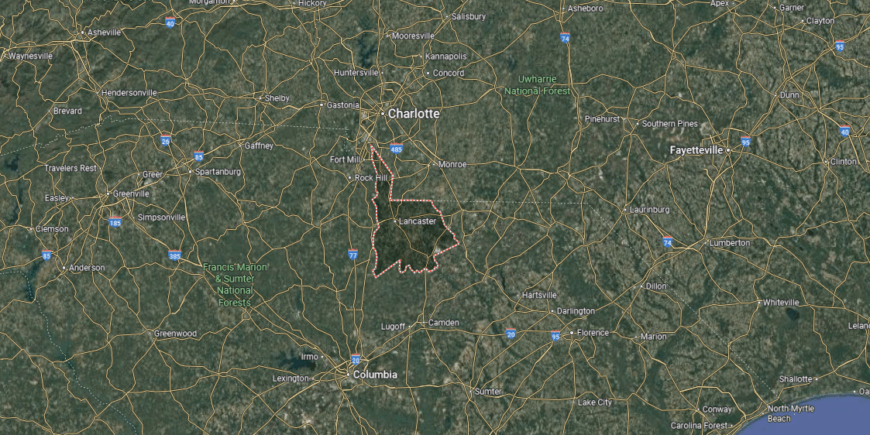
Lancaster County is situated in the north-central part of South Carolina, directly bordering North Carolina to the north. It is framed by York County to the west, Chesterfield County to the east, and Kershaw and Fairfield counties to the south. The county covers about 50 miles in length, with a mix of rolling Piedmont hills, river valleys, and expanding suburban areas tied to the Charlotte metropolitan region.
Lancaster, serving as the county seat, lies near the center, while Indian Land in the northern portion has become a fast-growing suburban hub. Other communities include Heath Springs to the south and Kershaw on the southeastern edge. With the Catawba River shaping its western boundary and its location within the Charlotte commuter belt, Lancaster County balances historic roots with modern development.
#15. Horry County, South Carolina
– Overall Rank: 530
– Population: 356,578
– Median household income: $59,880
– Median home value: $235,000 (75% own)
– Median rent: $1,128 (25% rent)
– Top public schools: HCS Early College High School (grade A+), Socastee Middle (grade A), Ocean Bay Middle School (grade A)
– Top private schools: St. Elizabeth Ann Seton Catholic School (grade A), Christian Academy of Myrtle Beach (grade B+), Conway Christian School (grade B+)
– Top places: Socastee (grade A minus), Surfside Beach (grade A minus), North Myrtle Beach (grade A minus)

About
Horry County, South Carolina stretches from the Atlantic shoreline to inland rivers and forests, creating a region defined by both coastal and rural traditions. Myrtle Beach, the county’s largest city, draws national attention as a hub for tourism and entertainment, while smaller towns and farmland preserve a quieter pace. The balance of seaside energy and inland heritage gives the county a unique and varied character.
Local life is enriched through festivals, markets, and school-centered activities that keep communities connected beyond the busy coast. Outdoor recreation thrives in state parks, waterways, and along the Grand Strand’s beaches. Horry County stands as a place where coastal vibrancy and rural strength come together to shape a diverse way of living.
Where is Horry County?
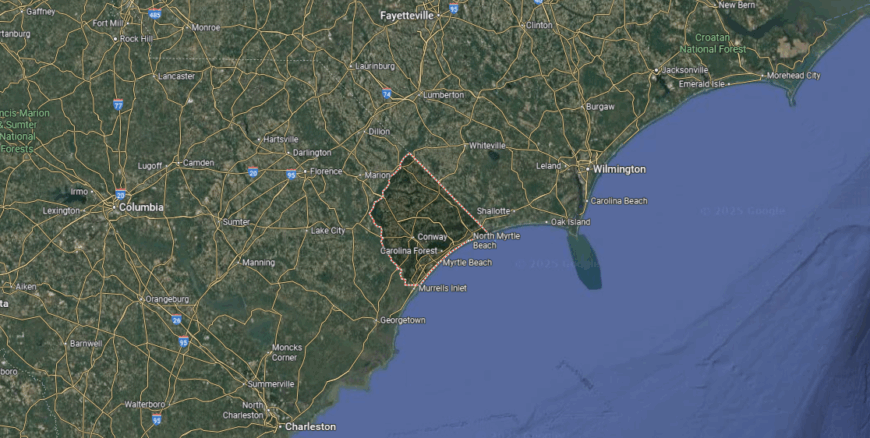
Horry County occupies the northeastern corner of South Carolina, bordered by North Carolina to the north and the Atlantic Ocean to the east. Inland, it meets Georgetown County to the south and Marion County to the west. Spanning more than 1,100 square miles, it is the largest county in the state, with landscapes ranging from coastal beaches to inland swamps and pine forests.
Conway, the county seat, is situated along the Waccamaw River near the center, while Myrtle Beach dominates the eastern shoreline as the county’s largest city. Other notable communities include North Myrtle Beach to the northeast and Loris in the inland north. With its extensive coastline, resort destinations, and waterways like the Intracoastal Waterway, Horry County is both a major tourist hub and a region of diverse natural settings.
#14. Florence County, South Carolina
– Overall Rank: 500
– Population: 137,015
– Median household income: $56,088
– Median home value: $157,400 (65% own)
– Median rent: $871 (35% rent)
– Top public schools: Royall Elementary School (grade B+), West Florence High School (grade B+), John W. Moore Middle School (grade B+)
– Top private schools: The King’s Academy (grade A minus), Florence Christian School (grade B+), Carolina Academy (grade B+)
– Top places: Florence (grade A minus), Lake City (grade C+), Timmonsville (grade C minus)

About
Florence County, South Carolina serves as a crossroads of the Pee Dee region, blending agricultural roots with a role as a center of commerce and healthcare. The city of Florence anchors the county with its historic districts, cultural institutions, and position as a hub for business and transportation. Beyond the urban core, farmland and smaller towns maintain a steady rhythm tied to tradition and rural life.
Residents gather through festivals, school activities, and civic events that strengthen ties across the community. Parks, rivers, and open countryside provide space for recreation while keeping residents connected to the land. Florence County reflects both progress and heritage, offering a balance of growth and enduring local identity.
Where is Florence County?
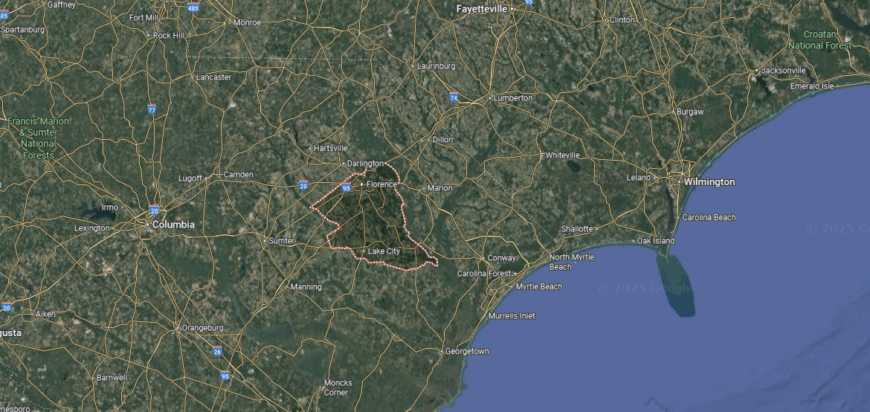
Florence County is located in the northeastern section of South Carolina within the Pee Dee region. It borders Darlington County to the north, Marion and Williamsburg counties to the east, and Lee County to the west. The landscape stretches about 40 miles across, marked by farmland, forests, and river valleys linked to the Great Pee Dee River.
Florence, the county seat and largest city, lies near the center and serves as a hub for transportation, health care, and commerce. Johnsonville, Pamplico, and Lake City are smaller communities that add to the county’s mix of rural and town life. Positioned along Interstate 95, Florence County connects agricultural lands with modern industry and regional trade routes.
#13. Kershaw County, South Carolina
– Overall Rank: 447
– Population: 65,779
– Median household income: $61,343
– Median home value: $173,800 (82% own)
– Median rent: $844 (18% rent)
– Top public schools: Wateree Elementary School (grade B+), North Central High School (grade B+), Blaney Elementary School (grade B+)
– Top private schools: Camden Military Academy (grade A), Cornerstone Christian School (grade unavailable)
– Top places: Lugoff (grade B+), Elgin (grade B+), Camden (grade B+)

About
Kershaw County, South Carolina is marked by its deep historic roots and its setting along the Wateree River and rolling Midlands terrain. The city of Camden, the county seat, is known as the state’s oldest inland town and preserves a legacy tied to the Revolutionary War and equestrian traditions. Across the county, small towns and rural landscapes reflect a balance of heritage and modern community life.
Residents engage in horse races, festivals, and civic gatherings that highlight both history and local pride. Outdoor recreation thrives in parks, rivers, and trails that keep the bond with nature strong. Kershaw County endures as a place where history, tradition, and community values remain central to daily living.
Where is Kershaw County?

Kershaw County is set in the north-central part of South Carolina, within the state’s Midlands region. It is bordered by Fairfield County to the west, Lancaster and Chesterfield counties to the north, and Lee and Sumter counties to the east and south. The county extends nearly 45 miles across, with rolling hills, river plains, and stretches of forestland defining its terrain.
Camden, the county seat, is located near the geographic center and is the oldest inland city in South Carolina. Other communities include Elgin in the southwest and Bethune to the northeast. With the Wateree River flowing along its western edge and historical sites tied to the Revolutionary War, Kershaw County combines natural waterways with deep historical roots.
#12. Dorchester County, South Carolina
– Overall Rank: 345
– Population: 162,139
– Median household income: $73,686
– Median home value: $273,000 (75% own)
– Median rent: $1,259 (25% rent)
– Top public schools: Rollings Middle School of the Arts (grade A), Ashley Ridge High School (grade A), Beech Hill Elementary School (grade A)
– Top private schools: Pinewood Preparatory School (grade A), Cathedral Academy (grade A minus), Dorchester Academy (grade C)
– Top places: North Charleston (grade B), Reevesville (grade B), Harleyville (grade C+)

About
Dorchester County, South Carolina sits at the edge of the Lowcountry, where pine forests, rivers, and historic towns shape its identity. The county seat of St. George and the well-known town of Summerville reflect both heritage and growth, balancing small-town character with expanding development. Agriculture, industry, and tourism together create a diverse foundation that sustains the region.
Community spirit is reflected through festivals, parades, and school-centered activities that bring residents together across generations. Natural preserves, rivers, and trails offer spaces for recreation and a lasting connection to the landscape. Dorchester County stands as a place where tradition, growth, and natural beauty come together in enduring form.
Where is Dorchester County?
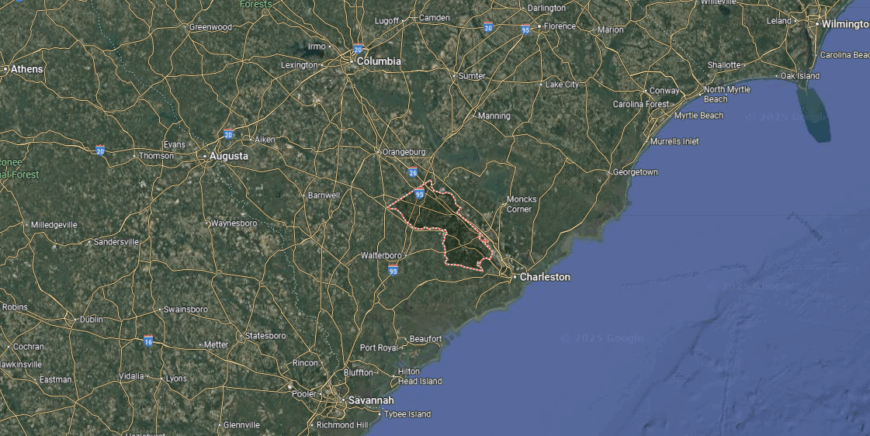
Dorchester County lies in the southeastern portion of South Carolina, forming part of the Charleston metropolitan area. It is bordered by Berkeley County to the northeast, Charleston County to the southeast, and Colleton County to the southwest. Covering more than 570 square miles, the county features a mix of pine forests, farmland, and growing suburban communities.
St. George serves as the county seat, positioned near the geographic center, while Summerville is the largest town and a major residential hub. Smaller communities include Ridgeville and Harleyville, both located in the northern section. With its proximity to Charleston, expanding neighborhoods, and natural settings along the Edisto River, Dorchester County blends rural character with suburban growth.
#11. Oconee County, South Carolina
– Overall Rank: 331
– Population: 78,775
– Median household income: $56,710
– Median home value: $192,800 (75% own)
– Median rent: $852 (25% rent)
– Top public schools: Walhalla Middle School (grade A minus), Northside Elementary School (grade A minus), Keowee Elementary School (grade A minus)
– Top private schools: Oconee Christian Academy (grade A minus), Trinity Baptist Preschool (grade unavailable), Foothills Christian School (grade unavailable)
– Top places: Seneca (grade B+), Utica (grade B), Walhalla (grade B)
You may also like: Counties with the most bridges in South Carolina

About
Oconee County, South Carolina lies in the foothills of the Blue Ridge Mountains, where rugged terrain, waterfalls, and lakes define its character. The county seat of Walhalla anchors civic life with historic landmarks while nearby towns like Seneca and Westminster add their own distinct identities. Agriculture, small industry, and outdoor tourism blend to sustain both economy and tradition.
Residents gather through music festivals, cultural events, and community fairs that highlight the region’s mountain heritage. Lake Jocassee, Lake Keowee, and the Chattooga River provide opportunities for recreation and connect people deeply to the land. Oconee County remains a place where natural beauty, heritage, and community spirit converge in lasting form.
Where is Oconee County?
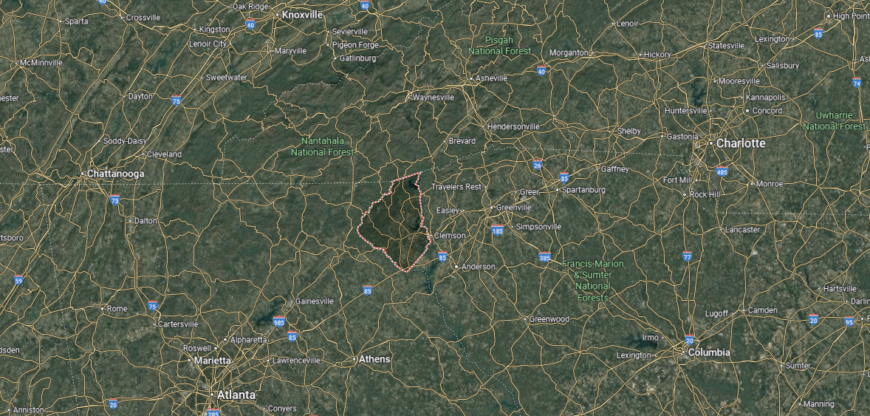
Oconee County is tucked into the northwestern tip of South Carolina, where the state meets both Georgia and North Carolina. It is bordered by Pickens County to the east, with the Blue Ridge Mountains rising along its northern edge and the Savannah River forming much of its western boundary. The county spans about 40 miles across, featuring rugged mountain terrain, forested lands, and large reservoirs.
Walhalla, the county seat, sits near the center, while Seneca and Westminster serve as additional population centers. Lake Keowee, Lake Hartwell, and Lake Jocassee highlight the county’s reputation for outdoor recreation and natural beauty. Known as the “Golden Corner” of South Carolina, Oconee County offers a unique mix of mountain landscapes, waterways, and historic towns.
#10. Aiken County, South Carolina
– Overall Rank: 314
– Population: 169,865
– Median household income: $63,212
– Median home value: $181,800 (75% own)
– Median rent: $973 (25% rent)
– Top public schools: Tall Pines STEM Academy (grade A minus), North Augusta High School (grade A minus), Chukker Creek Elementary School (grade B+)
– Top private schools: Mead Hall Episcopal School (grade A), South Aiken Baptist Christian School (grade B+), Victory Christian School (grade B)
– Top places: North Augusta (grade A), Aiken (grade A minus), Belvedere (grade B+)

About
Aiken County, South Carolina is defined by its position along the Savannah River and its blend of rural traditions with equestrian culture. The city of Aiken, the county seat, is widely recognized for its historic downtown, horse racing heritage, and role as a cultural hub. Surrounding towns and countryside carry forward a balance of farming, industry, and community-centered living.
Local life thrives through equestrian events, seasonal festivals, and gatherings that reflect both tradition and pride. Parks, trails, and riverfront areas offer recreation while maintaining a strong connection to the natural setting. Aiken County endures as a place where history, culture, and rural identity come together in a lasting way.
Where is Aiken County?
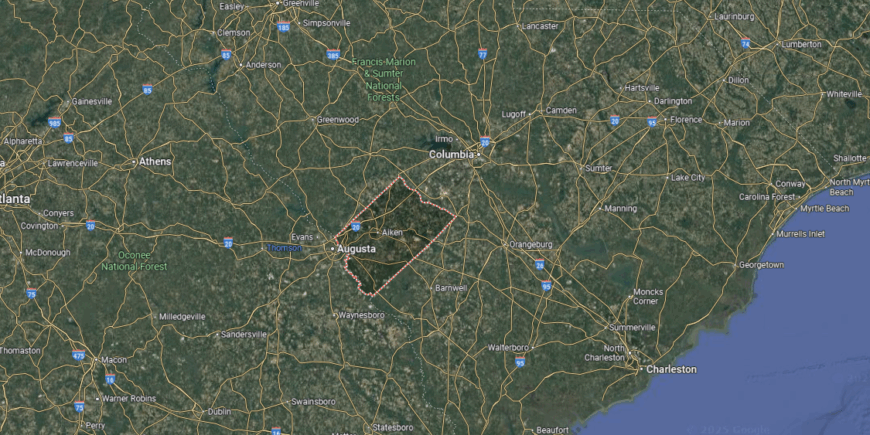
Aiken County is located along the western edge of South Carolina, sharing its border with Georgia across the Savannah River. It is bounded by Edgefield and Saluda counties to the north, Lexington County to the east, and Barnwell County to the south. The county covers over 1,000 square miles, blending river valleys, pine forests, and rolling sandhills.
The city of Aiken, serving as the county seat, lies near the center and is known for its role in equestrian culture and history. Other communities include North Augusta along the Georgia border and Wagener in the eastern section. With the Savannah River Site, historic downtowns, and abundant natural areas, Aiken County ties together industry, tradition, and outdoor spaces.
#9. Pickens County, South Carolina
– Overall Rank: 301
– Population: 131,106
– Median household income: $57,628
– Median home value: $196,600 (70% own)
– Median rent: $896 (30% rent)
– Top public schools: D.W. Daniel High School (grade A), Clemson Elementary School (grade A), R.C. Edwards Middle School (grade A minus)
– Top private schools: Lakeview Christian School (grade B+), Easley Christian School (grade C+), Clemson Montessori School (grade unavailable)
– Top places: Clemson (grade A+), Central (grade A), Easley (grade A minus)

About
Pickens County, South Carolina rests in the foothills of the Blue Ridge Mountains, where rugged landscapes and small towns define its setting. The city of Pickens serves as the county seat, preserving historic sites while nearby Easley and Clemson add energy through commerce and education. Agriculture, manufacturing, and the presence of Clemson University give the county a diverse and evolving identity.
Community pride is expressed through local festivals, school events, and cultural gatherings that bring residents together. Outdoor life thrives with hiking, fishing, and exploration of nearby state parks, lakes, and mountain trails. Pickens County remains a place where natural beauty, tradition, and growth create a distinctive balance.
Where is Pickens County?
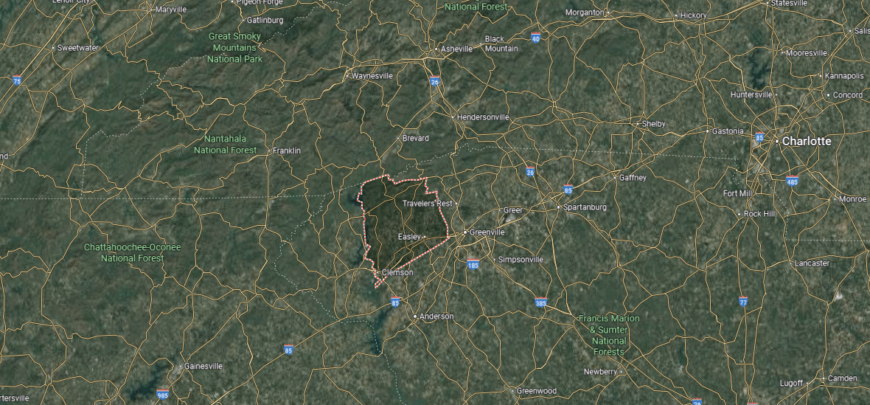
Pickens County sits in the northwestern corner of South Carolina, in the foothills of the Blue Ridge Mountains. It is bordered by Oconee County to the west, Greenville County to the east, and Anderson County to the south, while its northern edge touches North Carolina. The county spans about 40 miles across, with a landscape of mountain ridges, valleys, and rivers.
Pickens, the county seat, is located near the center, while Easley and Clemson are the largest cities. Clemson University anchors the eastern side of the county, shaping its educational and cultural presence. With natural landmarks such as Table Rock State Park, Lake Keowee, and the Saluda River, Pickens County offers a mix of mountain scenery, recreation, and small-town centers.
#8. Spartanburg County, South Carolina
– Overall Rank: 250
– Population: 330,119
– Median household income: $61,955
– Median home value: $195,800 (73% own)
– Median rent: $960 (27% rent)
– Top public schools: Pine Street Elementary School (grade A), Cooley Springs-Fingerville Elementary School (grade A), Shoally Creek Elementary School (grade A)
– Top private schools: Spartanburg Day School (grade A), Oakbrook Preparatory School (grade A), Spartanburg Christian Academy (grade A minus)
– Top places: Reidville (grade A), Boiling Springs (grade A), Duncan (grade A)

About
Spartanburg County, South Carolina is a cornerstone of the Upstate, long shaped by its textile heritage and now recognized as a center of industry and education. The city of Spartanburg, serving as the county seat, anchors cultural and civic life with universities, arts institutions, and historic districts. Surrounding towns and countryside reflect a blend of rural character and modern growth.
Residents engage in festivals, concerts, and community events that highlight both tradition and progress. Outdoor recreation is abundant in local parks, greenways, and lakes that connect people to the land. Spartanburg County stands as a region where history, innovation, and community values continue to shape everyday life.
Where is Spartanburg County?
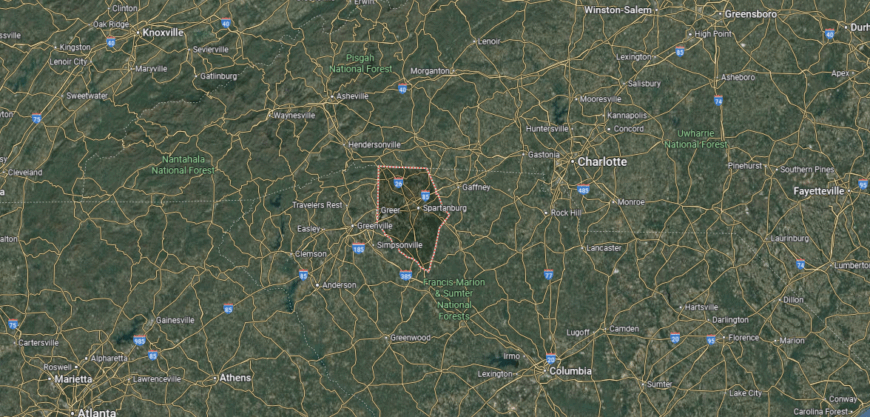
Spartanburg County is located in the northwestern region of South Carolina, within the state’s Upstate. It is bordered by Cherokee County to the northeast, Union County to the southeast, and Greenville County to the west, with North Carolina forming part of its northern boundary. The county stretches nearly 50 miles across, featuring rolling Piedmont hills, fertile valleys, and growing urban corridors.
The city of Spartanburg, the county seat, lies near the center and serves as the cultural and economic hub. Other notable communities include Boiling Springs, Duncan, and Woodruff, each contributing to the county’s blend of suburban and rural life. With its network of highways, Wofford College, and ties to manufacturing and commerce, Spartanburg County balances historic roots with modern development.
#7. Anderson County, South Carolina
– Overall Rank: 207
– Population: 204,592
– Median household income: $62,347
– Median home value: $189,400 (75% own)
– Median rent: $904 (25% rent)
– Top public schools: Southwood Academy of the Arts (grade A), Powdersville Elementary School (grade A), McCants Middle School (grade A)
– Top private schools: Montessori School of Anderson (grade A), Temple Christian Academy (grade B+), Anderson Christian School (grade B+)
– Top places: Pendleton (grade A+), Northlake (grade A), Powdersville (grade A)

About
Anderson County, South Carolina, often called the “Electric City,” reflects a legacy of innovation rooted in early hydroelectric power along the Seneca River. The city of Anderson, the county seat, anchors the region with cultural institutions, historic landmarks, and ties to commerce and industry. Across the county, small towns and farmland preserve a rural identity while contributing to a diverse economy.
Community spirit thrives through fairs, festivals, and gatherings that connect residents across generations. Lake Hartwell and nearby parks provide abundant opportunities for recreation and strengthen ties to the outdoors. Anderson County endures as a place where history, progress, and community pride come together in enduring form.
Where is Anderson County?
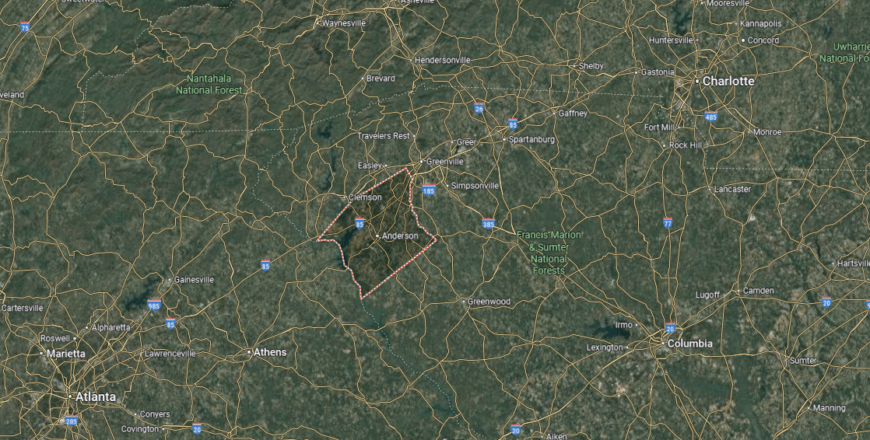
Anderson County sits in the northwestern part of South Carolina, within the state’s Upstate region. It is bordered by Oconee County to the west, Pickens County to the north, and Abbeville and Greenville counties to the east, while Georgia lies just across the Savannah River to the southwest. The county covers nearly 750 square miles, blending rolling Piedmont hills, farmlands, and expansive lakefronts along Lake Hartwell.
The city of Anderson, serving as the county seat, is positioned near the center and is often called the “Electric City” for its early embrace of hydroelectric power. Other communities include Belton, Honea Path, and Williamston, each adding to the county’s mix of small-town character. With Clemson University nearby, a strong manufacturing base, and recreational opportunities on Lake Hartwell, Anderson County combines education, industry, and outdoor living.
#6. Lexington County, South Carolina
– Overall Rank: 166
– Population: 295,934
– Median household income: $71,280
– Median home value: $197,600 (76% own)
– Median rent: $1,061 (24% rent)
– Top public schools: River Bluff High School (grade A), Meadow Glen Elementary School (grade A), Lexington High School (grade A)
– Top private schools: Northside Christian Academy (grade A minus), Grace Christian School (grade B+), Union United Methodist Church Kindergarten (grade unavailable)
– Top places: Lexington (grade A+), Seven Oaks (grade A), Cayce (grade A)
You may also like: Best scenic drives in South Carolina

About
Lexington County, South Carolina sits in the Midlands, where rapid growth blends with a long-standing rural foundation. The town of Lexington, serving as the county seat, anchors civic and cultural life while surrounding communities reflect both agricultural roots and suburban development. Lake Murray, a defining feature, connects the county through recreation, economy, and community identity.
Festivals, school-centered events, and neighborhood gatherings showcase strong civic pride and social connection. Outdoor opportunities on the lake, in parks, and along rivers keep residents linked to the natural setting. Lexington County stands as a dynamic blend of tradition and progress, shaped by both heritage and modern growth.
Where is Lexington County?
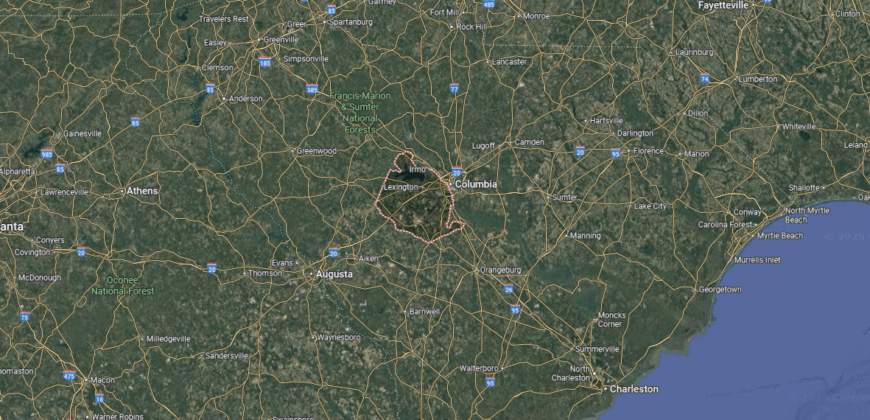
Lexington County is positioned in the central Midlands of South Carolina, west of the state capital of Columbia. It is bordered by Richland County to the east, Newberry County to the north, and Aiken and Orangeburg counties to the south. The county covers over 750 square miles, with a landscape that includes river valleys, farmland, and suburban developments.
The town of Lexington, serving as the county seat, sits near the center, while West Columbia, Cayce, and Irmo form part of the suburban corridor along the Congaree and Saluda rivers. Lake Murray dominates the northern section, providing both recreation and water resources to the region. With its blend of suburban growth, historic communities, and natural features, Lexington County serves as a key hub in the Midlands.
#5. Beaufort County, South Carolina
– Overall Rank: 144
– Population: 189,071
– Median household income: $81,260
– Median home value: $377,900 (76% own)
– Median rent: $1,435 (24% rent)
– Top public schools: Coosa Elementary School (grade A), Bluffton High School (grade A minus), Okatie Elementary School (grade A minus)
– Top private schools: Hilton Head Preparatory School (grade A+), Heritage Academy (grade A+), Beaufort Academy (grade A)
– Top places: Hilton Head Island (grade A), Bluffton (grade A minus), Port Royal (grade B+)

About
Beaufort County, South Carolina stretches across a coastal landscape of sea islands, marshes, and waterways that define its unique character. The city of Beaufort, with its preserved antebellum architecture, serves as a cultural and historic anchor for the region. Alongside it, communities such as Hilton Head Island and Port Royal reflect a mix of tradition, tourism, and modern growth.
Life in the county is tied closely to the water, from fishing and boating to festivals that celebrate coastal heritage. Natural preserves, beaches, and scenic byways offer recreation while protecting the Lowcountry’s beauty. Beaufort County endures as a place where history, culture, and the natural environment remain deeply intertwined.
Where is Beaufort County?
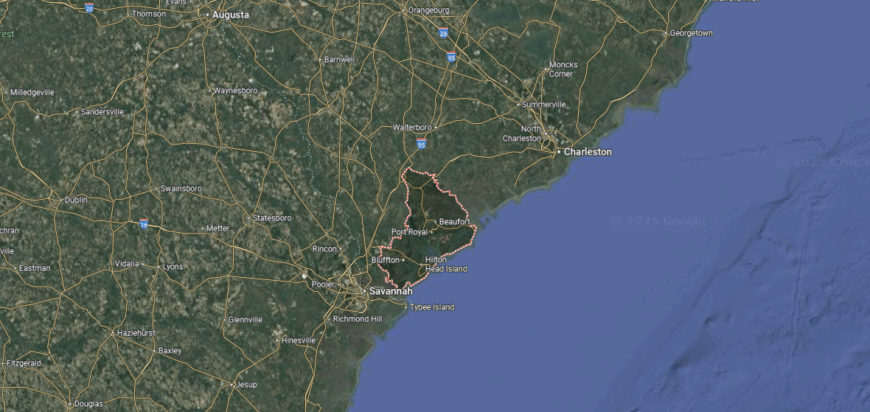
Beaufort County is located along the southernmost coast of South Carolina, bordered by Colleton County to the north and Jasper County to the west. To the east and south, the Atlantic Ocean shapes its shoreline, with barrier islands, tidal creeks, and marshlands defining much of its geography. Covering more than 800 square miles, the county is a mix of mainland areas and coastal islands.
The city of Beaufort, the county seat, lies on Port Royal Island, while Hilton Head Island and Bluffton stand as major population and resort centers. Smaller communities include Port Royal and St. Helena Island, each carrying deep historic and cultural roots. With its blend of coastal landscapes, Gullah heritage, and a strong tourism base, Beaufort County highlights both natural beauty and cultural richness.
#4. Richland County, South Carolina
– Overall Rank: 135
– Population: 416,161
– Median household income: $59,850
– Median home value: $201,200 (60% own)
– Median rent: $1,142 (40% rent)
– Top public schools: Spring Hill High School (grade A+), Lake Murray Elementary School (grade A), Oak Pointe Elementary School (grade A)
– Top private schools: Heathwood Hall Episcopal School (grade A+), Hammond School (grade A+), Ben Lippen School (grade A)
– Top places: Forest Acres (grade A+), Irmo (grade A), Blythewood (grade A)

About
Richland County, South Carolina is the heart of the Midlands, where history, government, and culture converge. The city of Columbia, the state capital and county seat, anchors the region with its universities, civic institutions, and historic neighborhoods. Beyond the urban center, smaller communities and rural areas preserve traditions tied to farming and local heritage.
Residents experience a strong cultural life through museums, festivals, and events that highlight both history and creativity. Outdoor spaces like Congaree National Park, rivers, and greenways connect people to the natural environment. Richland County remains a place where history, civic life, and community values create a vibrant and lasting identity.
Where is Richland County?
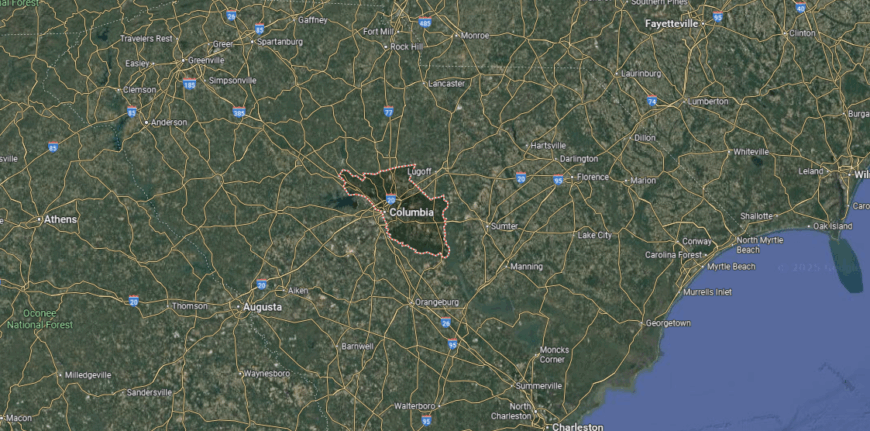
Richland County is situated in the central portion of South Carolina, forming the heart of the state’s Midlands region. It is bordered by Fairfield County to the north, Kershaw County to the northeast, and Lexington County to the west, while Sumter and Calhoun counties lie to the south. The county spans nearly 770 square miles, combining river valleys, forested tracts, and rapidly developing urban corridors.
Columbia, the state capital and county seat, dominates the central area along the Congaree River. Other communities include Forest Acres, Eastover, and Blythewood, each adding to the county’s mix of suburban and rural landscapes. With its role as the state’s political, educational, and economic center, along with institutions such as the University of South Carolina and Fort Jackson, Richland County anchors much of South Carolina’s identity.
#3. York County, South Carolina
– Overall Rank: 125
– Population: 282,987
– Median household income: $80,158
– Median home value: $287,600 (73% own)
– Median rent: $1,204 (27% rent)
– Top public schools: Pleasant Knoll Middle (grade A+), Gold Hill Elementary School (grade A+), Springfield Middle School (grade A+)
– Top private schools: St. Anne Catholic School (grade A), Walnut Grove Christian School (grade A minus), Lake Pointe Academy (grade A minus)
– Top places: Tega Cay (grade A+), Fort Mill (grade A+), Lake Wylie (grade A)

About
York County, South Carolina is set in the north-central Piedmont, where historic towns and growing suburban areas reflect both tradition and modern development. The city of York serves as the county seat, while Rock Hill stands as the largest city and a hub for education, industry, and culture. Agriculture and manufacturing continue to shape the county’s economy alongside expanding residential and commercial growth.
Local life is enriched by festivals, community gatherings, and historic sites that highlight the area’s heritage. Outdoor recreation thrives along Lake Wylie, the Catawba River, and regional parks that connect residents to the landscape. York County endures as a place where history, growth, and community identity come together in the South Carolina Upstate.
Where is York County?
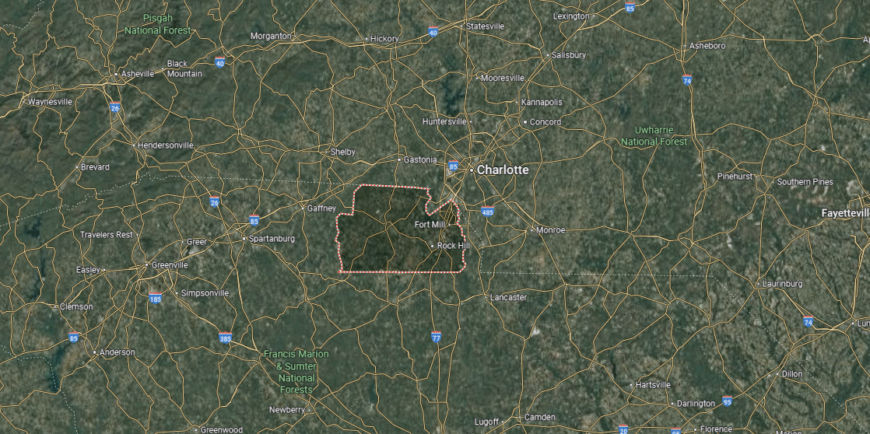
York County is located in the north-central section of South Carolina, directly along the border with North Carolina. It is bordered by Lancaster County to the east, Chester County to the south, and Cherokee County to the west. The county spans nearly 700 square miles, with rolling Piedmont hills and the Catawba River shaping much of its landscape.
York, the county seat, lies near the center, while Rock Hill stands as the largest city and a major part of the Charlotte metropolitan area. Other communities include Clover to the north and Fort Mill to the east, both of which have seen significant suburban growth. With its combination of historic towns, expanding neighborhoods, and access to Lake Wylie, York County balances tradition with modern development.
#2. Charleston County, South Carolina
– Overall Rank: 74
– Population: 409,840
– Median household income: $78,795
– Median home value: $415,000 (63% own)
– Median rent: $1,427 (37% rent)
– Top public schools: Academic Magnet High School (grade A+), Charleston School of the Arts (grade A), Wando High School (grade A)
– Top private schools: Porter-Gaud School (grade A+), University School of the Lowcountry (grade A), Charleston Collegiate School (grade A)
– Top places: Mount Pleasant (grade A+), Isle of Palms (grade A), Sullivan’s Island (grade A)

About
Charleston County, South Carolina is a coastal region where history, culture, and natural beauty intertwine. The city of Charleston, the county seat, is known for its historic architecture, port heritage, and role as a cultural center of the South. Surrounding islands, beaches, and rural communities balance tourism, agriculture, and preservation in ways that keep the county’s character distinct.
Life here flows through vibrant festivals, markets, and traditions that showcase both history and creativity. Outdoor spaces such as beaches, marshlands, and rivers offer recreation while connecting residents to the Lowcountry’s landscape. Charleston County endures as a place where past and present meet, shaping a lasting identity rooted in heritage and coastal life.
Where is Charleston County?
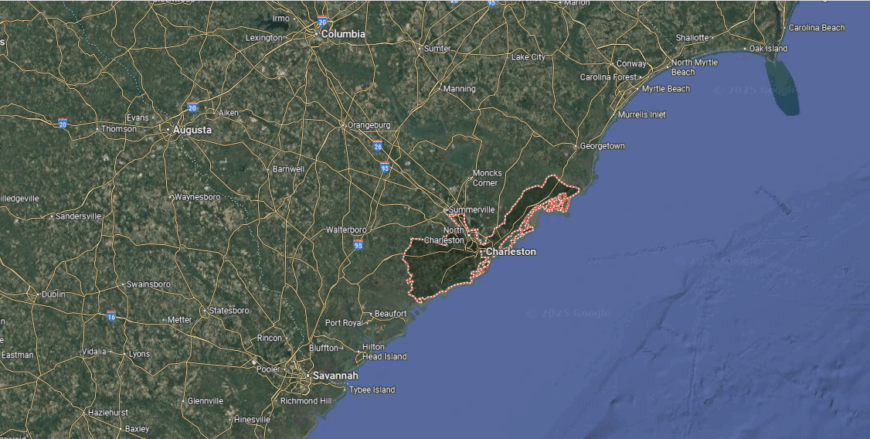
Charleston County stretches along the southeastern coast of South Carolina, covering a broad area of barrier islands, tidal marshes, and inland pine forests. It is bordered by Georgetown County to the northeast, Berkeley and Dorchester counties to the northwest, and Colleton County to the southwest, while the Atlantic Ocean frames its eastern edge. At more than 1,100 square miles, it is one of the largest counties in the state by land and water area.
The city of Charleston, serving as both the county seat and largest city, sits on a peninsula between the Ashley and Cooper rivers. Other communities include Mount Pleasant to the northeast, North Charleston inland, and smaller barrier island towns such as Isle of Palms, Sullivan’s Island, and Kiawah Island. With its historic port, cultural landmarks, and coastal landscapes, Charleston County blends centuries of heritage with modern growth and tourism.
#1. Greenville County, South Carolina
– Overall Rank: 24
– Population: 528,251
– Median household income: $71,328
– Median home value: $248,900 (69% own)
– Median rent: $1,122 (31% rent)
– Top public schools: Greenville Technical Charter High School (grade A+), SC Governor’s School for Arts & Humanities (grade A+), Sterling School (grade A)
– Top private schools: Christ Church Episcopal School (grade A+), Saint Joseph’s Catholic School (grade A), Southside Christian School (grade A)
– Top places: Five Forks (grade A+), Taylors (grade A), Wade Hampton (grade A)
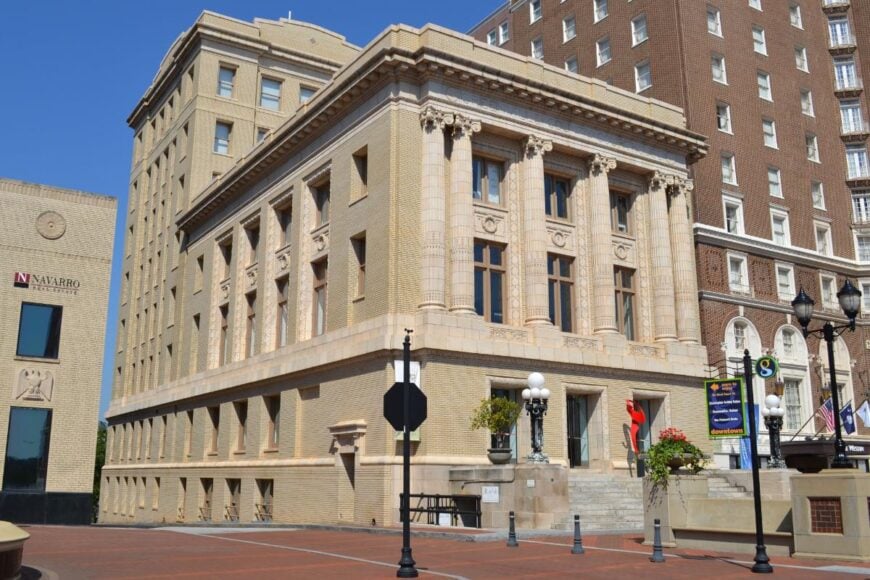
About
Greenville County, South Carolina is the state’s most populous county, where the Blue Ridge foothills meet a landscape of thriving towns and expanding industry. The city of Greenville, serving as the county seat, has grown into a cultural and economic hub with a revitalized downtown, historic districts, and strong ties to commerce. Beyond the urban core, farmland and smaller communities preserve the county’s rural foundation while contributing to its diverse character.
Residents take part in festivals, concerts, and civic events that showcase both tradition and innovation. Parks, trails, and natural areas, including the Reedy River and Paris Mountain, provide abundant opportunities for outdoor life. Greenville County stands as a dynamic region where history, growth, and community values continue to shape everyday living.
Where is Greenville County?
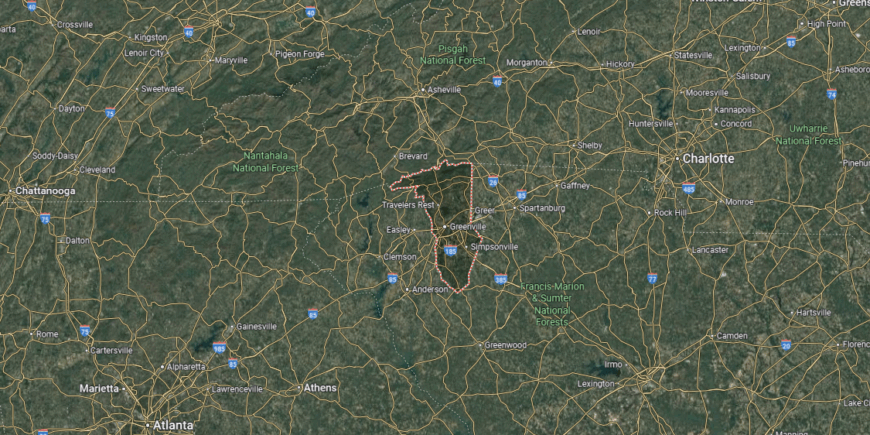
Greenville County is located in the northwestern corner of South Carolina, forming part of the state’s Upstate region. It is bordered by Spartanburg County to the east, Laurens County to the south, and Pickens County to the west, while North Carolina lies just across its northern boundary. At nearly 800 square miles, it is the most populous county in South Carolina, with a landscape of rolling hills, rivers, and growing urban centers.
The city of Greenville, serving as both the county seat and largest community, sits near the center and anchors the region’s cultural and economic activity. Other towns include Travelers Rest to the north, Simpsonville and Mauldin to the south, and Greer on the eastern edge. With the Reedy River, Paris Mountain, and a strong industrial base, Greenville County combines natural features with historic mill towns and rapid metropolitan growth.
This story features data reporting and writing by Elena Cox and is part of a series utilizing data automation across 50 states.
You may also like: How opioid prescriptions to Medicaid patients in South Carolina stack up
By Stacker



